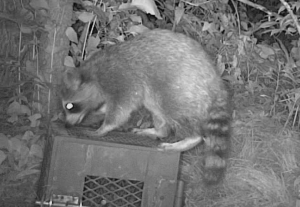Louis Lazure
PhD. Student
Contact Information
Department of Biology
Concordia University (Loyola Campus)
7141 Sherbrooke St. W. H4B 1R6
Montreal, QC, Canada
Office: SP301.16
Lab: SP434
(514) 848-2424 (ext. 4021)
Education
2017 – Present: PhD in Biology at Concordia University, Montreal, Canada
2007-2009: MSc Biology at Western University, London, ON
2005-2006: Master Biology – International Ecology at Université de Sherbrooke, QC
2002-2005: BSc Biology – Problem based learning at UQAM, MOntreal, QC
My Project
Behavioural impact of human presence on mammal mesopredators in protected areas
Background
When managing wildlife populations, designing protected areas, or considering animal reintroduction from a captive population, the behavioral aspect is often overlooked. Behaviour can be linked to survival or reproductive success, and to welfare. Behavioural responses to new challenges / environmental changes can be the result of immediate modification of individual behaviours, sometimes through a learning process, or of evolutionary adaptation. Behavioural traits can also be spatially distributed depending on their fitness values relative to local contexts. Habituation to humans will affect welfare in captive settings and can have lasting effect on wild populations. It can also lead to human-wildlife conflicts. Other aspects of behaviour, such as learning and problem-solving can exacerbate conflicts. Behaviour varies between species, population or even individuals. Therefore, conflicts can be addressed more precisely with problem populations or individuals.
Conflicts are present in and around protected areas, affecting wildlife and humans alike. Park visitors and park neighbours are two groups of people mostly involved in said conflicts. In Québec’s protected areas, mammal mesopredators (especially raccoon, but also skunk and red fox) are a recurring sources of human-wildlife conflict. Mammal mesopredators make for an interesting research model because they exhibit widely varying behaviours between and within species, many species are widely distributed and relatively abundant, and they are involved in conflict situations. Common species are also important to study because of their ecological impact as widespread keystone components of their communities.
Field Work
The research will be conducted at national parks in southern Québec, from the SÉPAQ network of protected areas. Sites will be selected based on the presence of studied species, occurrence of human-wildlife conflicts, and level of human activities. Some field work might be conducted in the peripheral zones of the parks.
Objectives
Review current knowledge on human-wildlife conflicts involving mammal mesopredators and explore the impact of human activities, density, and land protection statues. Investigate the difference in learning and problem-solving abilities between animals (individuals and/or species) in relation to their exposure to humans. Investigate the impact of habituation on wildlife and the probability of conflict. Investigate if the presence of a behavioural trait in a specific area is the result of learning and habituation, or of immigration and emigration.
Publications
- Lazure, L.*, Weladji, R. and Paré, P. 2022. Management and cognition of mammal mesopredators in relation to human presence. Symposium d’écologie comportementale de Montréal 2022. Montréal, QC. May 5 (poster)
- Lazure, L.* 2022. Cognition et gestion des mammifères mésoprédateurs interagissant avec les humains dans les aires protégées. Finale provinciale Ma Thèse en 180 secondes, Congrès de l’ACFAS. May 11 (oral)
- Lazure, L.*, Weladji, R.B. and Paré, P. 2021. Cognition of raccoons exposed to humans in protected areas. International Congress of Zoology. Virtual. Nov. 22-24 (oral)
- Pelletier, C., R.B. Weladji, L. Lazure & P. Paré (2020) Zoo Soundscape: Daily variation of low-to-high frequency sounds. Zoo Biology. 39(6):374-381.
- Lazure, L., P. Paré, L. Bouthillier & P. Galois (2019) Nesting biology and conservation of a northern population of spiny softshell turtles (Apalone spinifera). Herpetological Conservation and Biology. 14(3):659-667.
- Lazure* L. & R.B. Weladji (2019) Management and cognition of mammal mesopredators interacting with humans. Société Québécoise d’Étude Biologique du Comportement. 1-3 November, 2019, Montréal, Québec, Canada (poster)
- Paré* P., I. Devost* & L. Lazure* (2019) Zoo de Granby: Conservation and Research. Zoological Registrars Association. 7-13 October, Bromont, Québec, Canada (oral)
- Beaudin-Judd, J., Weladji, R.B., Lazure, L. and Paré, P. 2019. Activity budget and spatial distribution of Bennett’s wallabies (Macropus rufogriseus) in open versus closed exhibit designs. Zoo Biology. 38(3):258-265.
- Lazure L, Weladji RB (2018) Behaviour of mammal mesopredators interacting with humans in protected areas. Quebec Centre for Biodiversity Science. 11-12 December, 2018, Montréal, Québec, Canada (poster)
- Lazure L, Weladji RB (2018) Behaviour of mammal mesopredators interacting with humans in protected areas. Société Québécoise d’Étude Biologique du Comportement. 16-18 November, 2018, Trois- Rivières, Québec, Canada (poster)
- Pelletier C, Weladji RB, Paré P, Lazure L (2018) Impact of ultrasounds and visitor noise pollution on the behaviour and welfare of zoo captive animals. Association of Zoos and Aquariums. 23-27 September, 2018, Seattle, Washington, USA (poster)
- Couture, É.L., Ferrell, S.T., Desmarcheliers, M., Lazure, L. and Lair, S. 2017. Gastro-duodenal perforations and coelomitis in a group of juvenile Spiny Softshell Turtles (Apalone spinifera). Journal of Herpetological Medicine and Surgery. 27(1-2):36-43.
- Lazure, L., Paré, P., Tessier, N., Bourgault, P., Dubois, G., Canac-Marquis, P. and Lapointe, F.-J. 2016. Known range expansion and morphological variation in Southern Flying Squirrels (Glaucomys volans) in Québec. Canadian Field-Naturalist. 130(3):216-221.
- Gore, J.A., Lazure, L. and Ludlow, M.E. 2012. Decline in the winter population of Gray Bats (Myotis grisescens) in Florida. Southeastern Naturalist. 11(1):89-98.
- Lazure, L. and Fenton, M.B. 2011. High duty cycle echolocation and prey detection by bats. Journal of Experimental Biology. 214(7):1131-1137.
- Lazure, L., Bachand, M., Ansseau, C., and Almeida-Cortez, J. 2010. Fate of seeds consumed by white-lipped and collared peccaries (Tayassu pecari and Pecari tajacu) in the Atlantic rainforest, Brazil. Brazilian Journal of Biology. 70(1):47-53.
- Orbach, D.N., Veselka, N., Dzal, Y., Lazure, L., and, Fenton, M.B. 2010. Drinking and flying: Does alcohol consumption affect the flight and echolocation performance of Phyllostomid bats? PLoS ONE 5(2): e8993. doi:10.1371/journal.pone.0008993
- Lazure, L. and Almeida-Cortez, J. 2006. Impact des mammifères néotropicaux sur les graines. Neotropical Biology and Conservation. 1(2):51-61.
